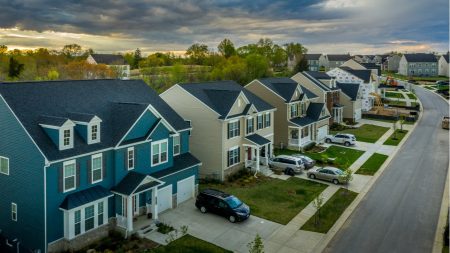MoMo Productions/Getty Images
All homeowners insurance policies are made up of several different coverage types, one of which is dwelling coverage. The dwelling coverage portion of a policy covers your home’s physical structure, including the roof, walls and foundation. Don’t confuse it with dwelling insurance, better known as a dwelling fire policy — that’s a whole different type of insurance form for property that you own but don’t live in full-time. The terms are a common source of confusion, but Bankrate’s team of insurance experts can help you better understand what dwelling coverage is and how it works.
What is dwelling coverage?
Dwelling coverage is included in all types of home insurance policies. If you look over your policy paperwork, you’ll also see it referred to as “Coverage A.” Dwelling coverage is what helps pay to rebuild or repair your home’s physical structure if it is damaged in a covered event. For example, if your home is completely destroyed in a fire, the dwelling coverage part of your policy would pay to rebuild it from the ground up. It’s not just for total losses; you can also file a claim for smaller repairs.
Dwelling coverage can help to repair or rebuild these parts of your home:
- Walls
- Foundation
- Roof
- Chimney
- Windows
- Attached deck
- Attached garage
- Permanent fixtures like countertops, cabinets, flooring and ceilings
Other parts of a homeowners insurance policy
Dwelling coverage is just one part of a homeowners policy. Remember, your insurance is split into different coverage types, all of which work together to protect the financial investment you’ve made in your home and belongings.
- Coverage type
- What it does
- Other structures (Coverage B)
- Helps pay to rebuild or repair standalone structures on your property like a shed or gazebo.
- Personal property (Coverage C)
- Covers personal belongings like your clothes and furniture.
- Loss of use (Coverage D)
- Also called additional living expenses, helps pay for hotel stays, meals and other expenses if you cannot live in your home after a cover loss.
- Personal liability insurance (Coverage E)
- Covers with legal fees and other expenses if you or a member of your household causes damage to others.
- Guest medical coverage (Coverage F)
- Helps pay for medical expenses if a guest is injured on your property, even if you’re not at fault for their injuries.
What does dwelling coverage cover?
Exactly what dwelling coverage applies to will depend on the type of home insurance policy you have. Home insurance policies vary in terms of what they cover and how they cover it. The two most common types of homeowners insurance policies — HO-3 and HO-5 — cover your home’s physical structure on an open-peril basis. This means you’re covered for any kind of damage, except that which is specifically excluded.
It’s also possible that your home insurance policy covers the dwelling on a named-peril basis. This means only things that are specifically listed in your policy are covered. In that case, you’re usually covered for losses stemming from:
- Fire
- Lightning
- Explosion
- Smoke
- Hail
- Windstorms
- Vandalism
- Theft
- Falling objects
- Aircraft and vehicles
- Weight of snow, sleet or ice
- Volcanic eruption
- Civil commotion and riot
What’s not covered under the dwelling portion of a homeowners policy?
Even if you have an open-peril policy, dwelling coverage doesn’t cover everything. Damage from the following won’t be covered by a standard insurance policy:
- Flooding
- Earthquakes
- Sewer backup
- Service line damage
- Neglect
- Intentional damage
Some of these, like sewer backup and service line damage, can be insured against if you purchase a policy add-on, called an endorsement. But again, your home insurance policy alone won’t cover those kinds of losses. Other sources of damage, like floods and earthquakes, usually require separate policies.
How much dwelling insurance do I need?
Most experts recommend that you have enough dwelling insurance to rebuild your home from the ground up if it’s destroyed in a covered loss. How much coverage you need isn’t the same as the home’s market price (or what you paid for it). The cost to replace your home will depend on a few different factors, including square footage, the number of rooms, the number of floors, the home’s age and its interior features. Inflation can affect the cost of construction materials, which also play a role in determining what it costs to rebuild a home — and, therefore, how much dwelling coverage you should have.
You might not always have the final say on what your dwelling limit is. If you have a mortgage, your lender may require you to insure your home for at least 80 percent of what it would cost to fully rebuild it. This is usually called the co-insurance clause.
What is extended dwelling coverage?
Let’s say your home is completely destroyed in a covered loss, and it would cost $325,000 to rebuild it. However, you only had $300,000 in dwelling coverage. In that case, an extended dwelling coverage endorsement would come in handy. If your dwelling coverage limit isn’t high enough to rebuild your home from the ground up, an extended dwelling coverage endorsement could help. This policy add-on can raise your dwelling limit by 10 to 50 percent. But, you can’t add an extended dwelling endorsement retroactively; it will need to be active on your policy before you file a claim.
Dwelling policy limits
Your dwelling coverage limit is one of the most important parts of your home insurance policy. Many of the other coverage types included in your policy — namely Coverage B, C and D — are calculated as percentages of your total dwelling limit. Exact percentages and coverage limits will vary, but generally, here’s what is allotted for each coverage type:
- Coverage type
- Percentage
- Other structures (Coverage B)
- 10% of dwelling limit
- Personal property (Coverage C)
- 50% to 70% of dwelling limit
- Loss of use (Coverage D)
- 20% to 30% of dwelling limit
Dwelling policy deductibles
Say your roof sustains hail damage, or burglars break down your front door. In that case, you could file a claim with your home insurance company for the cost of the damage. Your home insurance company won’t pay for everything, though; you are still financially responsible for your policy’s deductible. Amounts can vary, but it’s normal for a deductible to be anywhere from $500 to $5,000. You can use your deductible to help determine whether or not it’s worthwhile to file a claim. Filing a home insurance claim could raise your premium when your policy renews. As a rule of thumb, most insurance experts recommend not filing a claim unless the estimated repair costs are significantly higher than your deductible.
Frequently asked questions
Read the full article here










